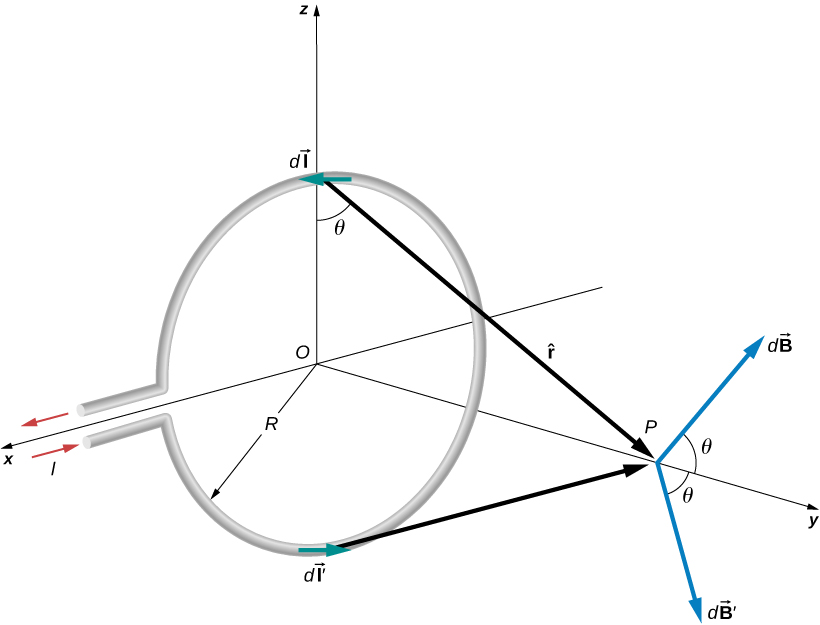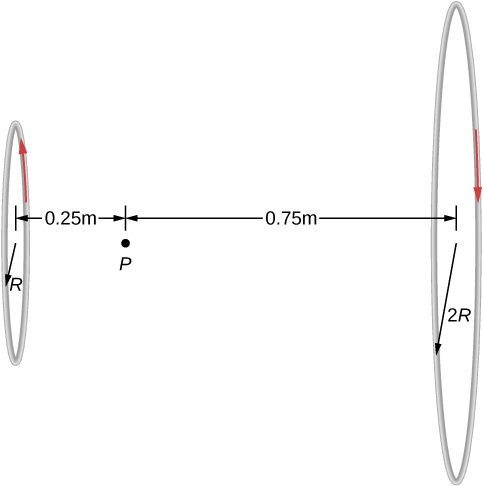12.5: Magnetic Field of a Current Loop
( \newcommand{\kernel}{\mathrm{null}\,}\)
By the end of this section, you will be able to:
- Explain how the Biot-Savart law is used to determine the magnetic field due to a current in a loop of wire at a point along a line perpendicular to the plane of the loop.
- Determine the magnetic field of an arc of current.
The circular loop of Figure 12.5.1 has a radius R, carries a current I, and lies in the xz-plane. What is the magnetic field due to the current at an arbitrary point P along the axis of the loop?

We can use the Biot-Savart law to find the magnetic field due to a current. We first consider arbitrary segments on opposite sides of the loop to qualitatively show by the vector results that the net magnetic field direction is along the central axis from the loop. From there, we can use the Biot-Savart law to derive the expression for magnetic field.
Let P be a distance y from the center of the loop. From the right-hand rule, the magnetic field d→B at P, produced by the current element Id→l is directed at an angle θ above the y-axis as shown. Since d→l is parallel along the x-axis and ˆr is in the yz-plane, the two vectors are perpendicular, so we have
dB=μ04πIdlsinπ/2r2=μ04πIdly2+R2 where we have used r2=y2+R2.
Now consider the magnetic field d→B′ due to the current element Id→l′, which is directly opposite Id→l on the loop. The magnitude of d→B′ is also given by Equation ???, but it is directed at an angle θ below the y-axis. The components of d→B and d→B′ perpendicular to the y-axis therefore cancel, and in calculating the net magnetic field, only the components along the y-axis need to be considered. The components perpendicular to the axis of the loop sum to zero in pairs. Hence at point P:
→B=ˆj∫loopdBcosθ=ˆjμ0I4π∫loopcosθdly2+R2.
For all elements d→l on the wire, y, R, and θ are constant and are related by
cosθ=R√y2+R2.
Now from Equation ???, the magnetic field at P is
→B=ˆjμ0IR4π(y2+R2)3/2∫loopdl=μ0IR22(y2+R2)3/2ˆj where we have used ∫loopdl=2πR. As discussed in the previous chapter, the closed current loop is a magnetic dipole of moment →μ=IAˆn. For this example, A=πR2 and ˆn=ˆj, so the magnetic field at P can also be written as
→B=μ0μˆj2π(y2+R2)3/2.
By setting y=0 in Equation ???, we obtain the magnetic field at the center of the loop:
→B=μ0I2Rˆj.
This equation becomes B=μ0nI/(2R) for a flat coil of n loops per length. It can also be expressed as
→B=μ0→μ2πR3.
If we consider y>>R in Equation ???, the expression reduces to an expression known as the magnetic field from a dipole:
→B=μ0→μ2πy3.
The calculation of the magnetic field due to the circular current loop at points off-axis requires rather complex mathematics, so we’ll just look at the results. The magnetic field lines are shaped as shown in Figure 12.5.2. Notice that one field line follows the axis of the loop. This is the field line we just found. Also, very close to the wire, the field lines are almost circular, like the lines of a long straight wire.

Two loops of wire carry the same current of 10 mA, but flow in opposite directions as seen in Figure 12.5.3. One loop is measured to have a radius of R=50cm while the other loop has a radius of 2R=100cm. The distance from the first loop to the point where the magnetic field is measured is 0.25 m, and the distance from that point to the second loop is 0.75 m. What is the magnitude of the net magnetic field at point P?

Strategy
The magnetic field at point P has been determined in Equation ???. Since the currents are flowing in opposite directions, the net magnetic field is the difference between the two fields generated by the coils. Using the given quantities in the problem, the net magnetic field is then calculated.
Solution
Solving for the net magnetic field using Equation ??? and the given quantities in the problem yields
B=μ0IR212(y21+R21)3/2−μ0IR222(y22+R22)3/2
B=(4π×10−7T⋅m/A)(0.010A)(0.5m)22((0.25m)2+(0.5m)2)3/2−(4π×10−7T⋅m/A)(0.010A)(1.0m)22((0.75m)2+(1.0m)2)3/2
B=5.77×10−9T to the right.
Significance
Helmholtz coils typically have loops with equal radii with current flowing in the same direction to have a strong uniform field at the midpoint between the loops. A similar application of the magnetic field distribution created by Helmholtz coils is found in a magnetic bottle that can temporarily trap charged particles. See Magnetic Forces and Fields for a discussion on this.
Using Example 12.5.1, at what distance would you have to move the first coil to have zero measurable magnetic field at point P?
- Solution
-
0.608 meters


